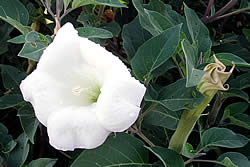Plant of the Week
 Range map of sacred thorn-apple. States are colored green where the species may be found.
Range map of sacred thorn-apple. States are colored green where the species may be found.
Note the open sacred thorn-apple blossom on the left and the flower bud that will open the next day on the right. Photo by Charlie McDonald.
Sacred thorn-apple (Datura wrightii)
By Charlie McDonald
Sacred thorn-apple is a member of the nightshade family (Solanaceae). This large family of about 2,000 species abounds in plants with medicinal or poisonous properties, and family members like potato, tomato, eggplant, red pepper, and tobacco are of great economic importance. Sacred thorn-apple falls into the poisonous category.
Sacred thorn-apple grows almost throughout the United States. It resembles jimsonweed (Datura stramonium), which is even more common, but sacred thorn-apple is a larger plant and has more spines on its fruits.
This plant grows best in loose disturbed soils. A healthy plant can be 4 to 6 feet across and 3 feet tall. With regular watering, it will bloom all summer. Individual blossoms are about 8 inches long and 6 inches across. They open in the evening with a sweet scent and wilt by mid-morning the next day.
Sacred thorn-apple is a low maintenance, low water, native plant that has found a place in landscaping, at least in the Southwest where container-grown plants are available from native plant nurseries. Give sacred thorn-apple plenty of room when planting because it will overtake and smother nearby plants. The entire plant is poisonous if ingested, especially the seeds, so don’t plant it where small children will be playing.


